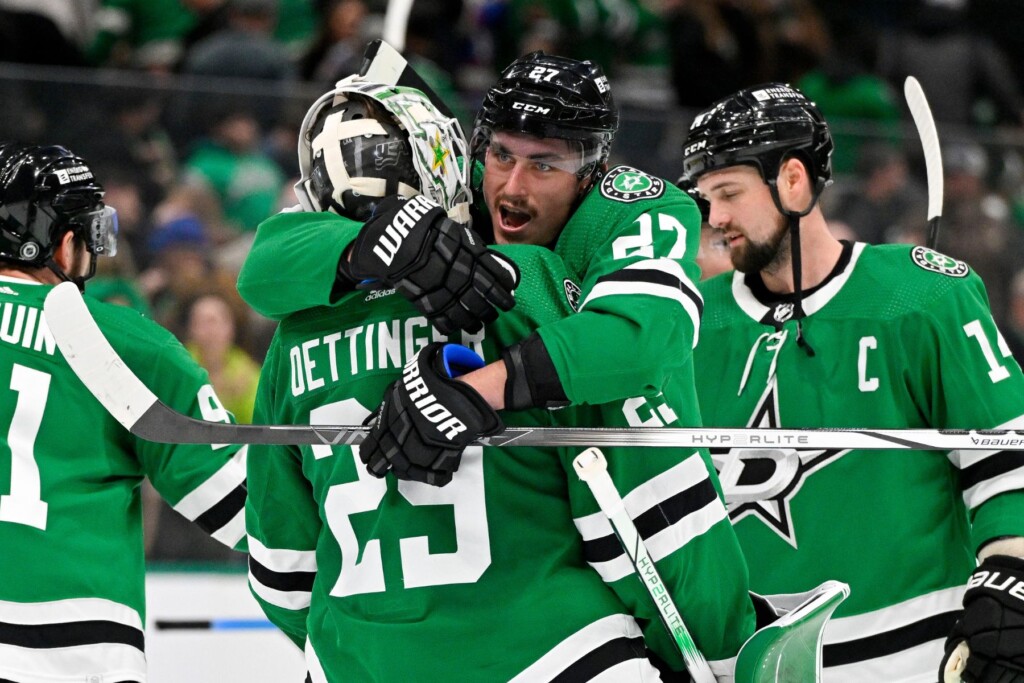A funny thing is happening in the NHL. In a league typically headlined by two or three Cup contenders, this season there’s enough for an ocean’s heist. As The Athletic’s Dom Luszczyszyn pointed out, an unprecedented 10 teams have a greater than 5 percent chance to win the Cup. You don’t have to do the math to know this checks out. Boston, Colorado, Florida, the New York Rangers, Winnipeg — and yes, Dallas — are all seen as legit. Per MoneyPuck’s odds, the Stars are particularly high on this list, ranking fourth as the odds-on favorite.
And yet the Stars have a major problem, and it’s not a problem they’re going to fix at the trade deadline. No, I’m not talking about their blueline, which is flawed but has helped contribute to the top-ranked team in expected goals-against. And I’m not talking about the minutiae of whether the top line is firing on all cylinders. I’m talking about goaltending.
When stacked against the other contenders, Dallas is built differently in this regard. The Stars have a number one starter in Jake Oettinger. The last two Cup winners ditched this schematic. Vegas didn’t need its starter, Logan Thompson, to come through when it mattered most. Instead it was Adin Hill, backing up Laurent Brossoit, who took the netminding reins en route to the 2023 Stanley Cup. The year before that it was Colorado juggling the duo of Darcy Keumper and Pavel Francouz. There are obvious problems with this approach. However, the Stars are experiencing the obvious problems with the opposite strategy; namely that they’re stuck dancing with the one they brought.
Normally this would be fine. But there’s nothing normal about the season Oettinger is having. The lower-body injury he suffered against the Ottawa Senators in December that sidelined him for 12 games was abnormal, but so was the season he was having before that point.
The Stars look fine on the surface. In addition to the oddsmakers, they rank seventh in points percentage. They’re top 10 in special teams, ranking 10th on the power play and fifth on the penalty kill. They’re scoring a lot of goals thanks to some mind-boggling depth, but they’re struggling to stop shots from going in. With 128 goals allowed, Dallas ranks 15th in the league. As a group, its save percentage of .898 is exactly average, at 16th. Oettinger’s .905 save percentage (.902 before the big win over L.A.) makes him the ever-so-slightly better half of the top duo, with Scott Wedgewood sitting just behind him at .897. But despite those very underwhelming numbers, Dallas hasn’t been punished in the standings.
Given Oettinger’s struggles, it shouldn’t be surprising to see that Dallas was fine without him. During his absence, the Stars went 7-3-2. The team’s save percentage at even strength was .907, well above Oettinger’s pre-injury .896 even-strength save percentage. Granted, the word “fine” is written with a heavy layer of caution. After all, these numbers aren’t really that interesting. In the same way plus/minus doesn’t qualify as a useful heuristic for performance and is thus misleading, the trend of Wedgewood winning more games (12-4-3) than Oettinger (12-8-2) doesn’t mean Wedgewood should be up for the starter role.
Still, something’s up. Let’s dig deeper and compare their workloads. Below is a look at expected goals, or xG, versus goals allowed. Pay attention to the four quadrants and think of them in terms of light workload and watertight (top left), heavy workload and watertight (top right), light workload and leaky (bottom left), and heavy workload and leaky (bottom right).
It’s not a huge difference, but it’s clearly defined: Wedgewood faces less shot quality and allows more goals, while Oettinger has a more difficult workload and allows more than you’d expect. Per Natural Stat Trick, Oettinger is facing almost two more high-danger shots per game (7.38) than Wedgewood (5.64). Normally this would make intuitive sense because you would expect Wedgewood to get the easier starts. Except Wedgewood has faced eight playoff teams while Oettinger has faced 13—not exactly a world of difference if we’re looking only at quality of competition.
Normally I’d parse through more details because that’s what I love to do. I’d love to address the voodoo going on. Why is Wedgewood almost leading the league in shot attempts off the rush per game while Oettinger isn’t even top 30? Why is Oettinger struggling at even strength but is so good on the penalty kill? (He ranks second among goalies with at least 100 shorthanded minutes.) But the simple truth of that matter is that even the best goaltenders, from Connor Hellebuyck to Andrei Vasilevskiy, will struggle to give you high-level consistency across multiple seasons, whether you’re looking at basic save percentage or something deeper, like goals saved above expected. The other end of that consistency coin is happening all around the league. Just look at the goaltenders who were written off last year who are now getting their groove back, including Joey Daccord, Jacob Markstrom, and Cam Talbot.
While the thought of Dallas’ starting netminder struggling might seem sobering, it’s really not. For one, a tough regular season doesn’t guarantee a bad postseason. Dallas can still trust Oettinger. From 2020 to 2023, he ranked 11th in goals saved above expected, just below Filip Gustavsson, Semyon Varlamov, and Jeremy Swayman. Historically, he’s going to make more quality saves than not even if he’s not on the level of a Connor Hellebuyck or an Igor Shesterkin. (And for all we know, maybe the reset and a big win over the Kings is just what Oettinger needs to get going again.)
Two: Pete DeBoer can trust his backups. Wedgewood may not be great, but backups aren’t supposed to be great; like henchmen, they’re temporary obstacles of varying degrees and Wedgewood is a capable henchman in that regard. Then there’s Matt Murray. He has been solid for the Texas Stars with three stints featuring the following save percentages: .947, .911, and .908. He’s also 25. If Dallas wants to learn more about him, now’s the time. It would be foolish not to. (Sure enough, Murray got his first career shutout last week in a 4-0 road win over Minnesota.) The Stars have already seen what happens when you overwork your starter.
These might not look like good options, but look how far the Stars have gotten despite having the 19th-ranked save percentage. This is where I need to second Robert Tiffin’s article not just as a piece of writing I hold in high regard, but as a salient point that bears repeating: Dallas can afford to explore the unknown. An actionable item tomorrow—i.e., finding out more about Murray the same way Vegas found out more about Hill—is better than an unlearnable action item today. In other words, why consider Oettinger as the only option in games that are treated as must-win?
Goaltending may be voodoo, but that doesn’t mean everything else has to be. The Stars are a very good team with below-average goaltending. Great goaltending would be nice, but maybe they just need to work toward a clearer picture. Given how fast things can change at the position, it may eventually lead them back to a place of strength in net.
Author








